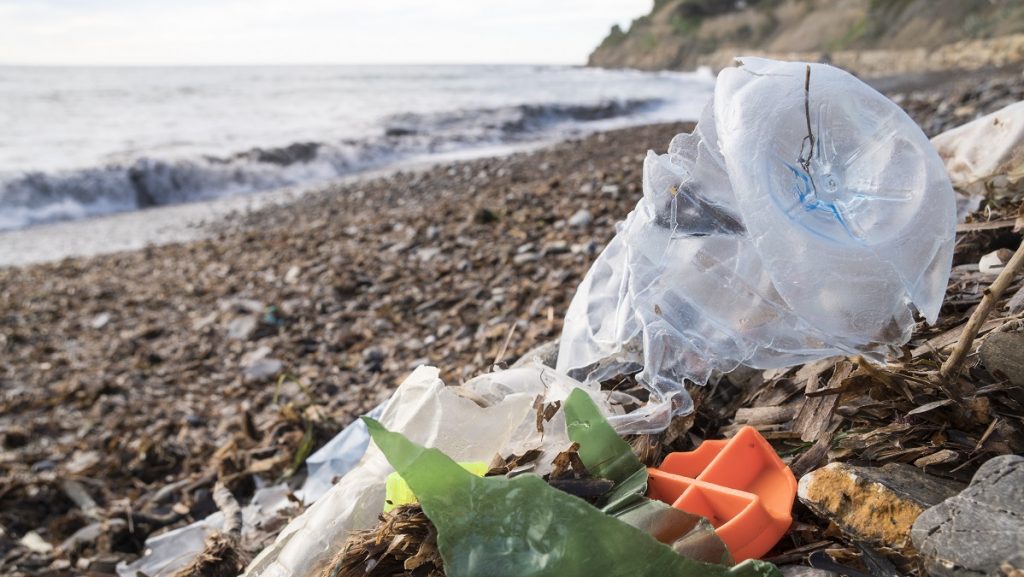Sustainability: The Future of Business

by Ivana Gazibara and Jonathon Porritt
Industry View
Action on plastic pollution: from start-up to acceleration
Share on facebook
Share on twitter
Share on linkedin
The past year witnessed an unprecedented level of interest in plastic pollution. It was the year that the Ocean Rescue and Blue Planet 2 TV programmes sparked outrage and sadness about our plastics addiction and the environmental damage it is doing to the planet, particularly the oceans. The twittersphere was in overdrive with emotional messages and promises to never use a single plastic bag again. But will it stick?
Forum for the Future and Sky have been working together to assess the extent and transformational potential of the change in plastics we’ve seen so far (a study that will be published shortly) and, as 2018 draws to a close, it is useful to take stock, and look forward to what is needed next to tackle this complex challenge.
It was only in 2014 that we discovered that more than five trillion pieces of plastic are in the world’s oceans, a large proportion of which are from single-use packaging. Soon after that, microbeads hit the headlines. Greenpeace campaigned for a ban, and at the end of 2015 the US delivered. By the following year, more than 300,000 people signed a petition asking for the same ban in the UK, and the government rapidly acceded.
Today, there are countless plastics campaigns, from the Surfers Against Sewage Plastics Free Coastlines initiative, to MSC’s Plastic Challenge, to the UN’s #CleanSeas work. Awareness of plastics pollution is at an all-time high, providing an incredibly important window of opportunity for radical change.
That window was blown open when Blue Planet 2 aired. It was the most-watched BBC programme of 2017, and it helped catalyse a wave of activity. The BBC itself committed to go plastics-free, directly referencing the impact of the programme, and a number of businesses followed with a range of targets – albeit variable in their levels of ambition – around plastics. Sky has set itself a bold target of phasing out all single-use plastics (SUPs) from its operations, supply chain, and products by 2020. And frozen food giant Iceland has committed to eliminating all plastic packaging from its own-label products by 2023, to name a couple of the most ambitious.
More recently, UK retailers such as Tesco, Asda and Waitrose have announced they will stop selling 5p SUP carrier bags. And fast-moving consumer goods companies have been on the move as well. In 2017, Unilever pledged to use 100 per cent reusable, recyclable or compostable plastic packaging by 2025. Since then, other big brands have signed up to the same targets. Nothing like some good old-fashioned competition!
That said, most corporate commitments are simply not bold enough. Given that we essentially need to turn the tap off on plastics entering the oceans, you could argue this about pretty much any target that essentially just incrementally increases the recyclability or recycling rates of plastic packaging. These will not fundamentally change the massive throughput of material and energy that circulate in our economies, nor will they prevent plastic packaging leaking into the environment.
Measures such as these risk reinforcing the idea that we can continue to consume massive amounts of goods encased in “throwaway” packaging. Solutions such as beach clean-ups and ocean-cleaning technologies feel similarly “band-aid” in the context of the scale of the challenge. What the world is crying out for is a profound shift in how we think about the items we buy and consume.
New policy and regulation is emerging, arguably far faster than would have been the case without such huge public concern. The European Parliament recently voted for an extensive ban on SUPs, including products such as plates, cutlery, straws and cotton buds. Other governments have announced similar bans on SUPs: Taiwan by 2030, and Costa Rica and India by 2021 and 2022, respectively.
However, most policies have focused on individual products such as plastic bags or straws, which only represent a small percentage of the plastic waste problem, rather than putting in place legislation and incentives designed to create a bigger shift in how we produce, consume and manage end of life in plastic. This also allows issues to be seen as resolved when they are not.
For example, none of the numerous national microbead bans apply to every product that contains microbeads – suncream, makeup and paint are generally exempt, for example. And levels of effectiveness vary. A UN study of more than 60 national bans and levies on plastic bags found that only 30 per cent had evidence of a positive impact. Lack of enforcement, affordable alternatives and impact measurement were key reasons for this low reported success rate.
Beyond that, a variety of niche innovations are bubbling up from the edges. Ooho has made waves with its algal-based edible water “pouches”, which are now featured at Selfridges. A group of Japanese scientists is working on a new species of bacteria (Ideonella sakaiensis) that “eats” PET. Ecovative have designed a new form of packaging made of mushroom “roots” – cheap, plentiful, easy to grow, and biodegradable. And the Ekoplaza store in Amsterdam has opened the world’s first plastic-free supermarket aisle, which it will rollout to all of its 74 branches by the end of the year.
Arguably though, the most interesting innovations are not the ones that come up with novel materials, but rather different ideas and business models for how we relate to plastic and to packaging more broadly. Cupclub, for example, is a circular-economy service that aims to eliminate single-use coffee cups by supplying reusable RFID-tagged biodegradable cups to cafes where customers use them and then drop them off at collection points, from where they are taken to a washing centre before being redistributed back to retail outlets.
Precious Plastic is an outfit that has created at-home plastic recycling and 3-D printing machines, along with design templates providing guidance for people on what they can remake their plastic waste into – it even hosts an online marketplace for the objects created by its customer base, which range from flowerpots to wall clocks. And innovative deposit return schemes (DRS) in Beijing, Jakarta and Istanbul are enabling people to pay for services such as public transport by trading their plastic waste for credit through reverse vending machines.
So, plastics is at an inflection point: we know what the issues are, we understand the need for change, and there are some genuinely pioneering practices out there, from corporate commitments to disruptive innovations to legislation. But the critical point in any change story is scaling and sustaining that change so that it effectively becomes the ‘new normal’. For plastics, that means:
Building change communities
Collaborative initiatives such as the New Plastics Economy, WRAP’s Plastics Pact, and GPAP are a good start, but there’s far more still to be done – and collaboration at scale is absolutely critical to move some of the most interesting innovations from niche to mainstream. Many are making commitments, but few are joining forces to ensure those commitments add up to a commonly held vision for change, and to genuinely share approaches and learning. And, frankly, some of the commitments are not bold enough, given the scale of the challenge. It will be vital to create networks for change that identify, design and pilot solutions that demonstrate a radically different plastics system, and share learning from that process widely.
‘Recyclable’ is not good enough
There have been signals of change in the plastics space as of late that suggest that we might be entering a phase of accelerated change, including more meaningful policy moves, as well as shifts in consumer attitudes to plastic packaging. This pattern could eventually result in disruption for businesses with incremental targets around things such as recycling. We must keep pushing the elimination of avoidable or unnecessary SUPs, such as plastic bags, straws, coffee stirrers, soda and water bottles and most food packaging.
They should be replaced with alternative materials (compostable or recyclable), but while making sure that we fully understand all the impacts of such materials, and that appropriate collection and waste management infrastructure is put in place to support this transition.
A key part of the plastics challenge is not just what’s recyclable, but what’s actually recycled. The reality is that only 14 per cent of global plastic packaging is collected for recycling, with chronic infrastructure deficits in many countries. This was powerfully demonstrated when China banned the import of plastic waste at the end of 2017, a move that left the British recycling industry in disarray. Two-thirds of our recycled waste was exported to China, and will now need to be incinerated, landfilled or exported elsewhere.
That ban has created a bottleneck already, leading to widespread allegations of waste fraud as the UK has been diverting its recycled waste to markets such as Malaysia and Vietnam, which are unable to cope with the volume, leading to the use of illegal dumpsites.
We must ensure the plastic that remains in the system is recyclable – and recycled. Plastic recycling collection must be streamlined, with clear and well-enforced rules. Recycling infrastructure must meet demand and be appropriate to local needs, and recycling technologies must be combined to maximise the materials that can be recycled.
Tackling the elephant
Greenpeace is right to call for a shift in emphasis “from one of individual responsibility towards corporations reducing their production of throwaway plastic packaging”. Yet we still have to address most people’s dominant attitude to consumption. Our current “normal” means rapidly consuming the stuff we buy, and throwing away the packaging. If all we end up with at the end of this change process is society being more willing to recycle, this will be a failure.
True enough, there is some evidence of change in societal habits in this area, supported by the right set of policy interventions. When the 5p plastic bag charge came into place in this country in 2015, for example, there was a lot of doubt as to its impact. And yet, less than a year later, England’s plastic bag usage dropped by 85 per cent. And we know that there are more ambitious schemes that have had similar effects in other countries, such as the bottle take-back system in Norway. Looking forwards, it will be fascinating to see who cracks the whole refill challenge. The Ellen MacArthur Foundation estimates that reuse models are economically attractive for at least 20 per cent of plastic packaging (by weight), to the tune of $9billion.
We need initiatives, ideas and models that challenge the very essence of our pervasive and hugely destructive throwaway culture. Those horrendous gyres of plastic waste across our oceans provide the most visibly compelling proof we’ve ever had that there is no “away” on planet Earth. And there never will be.
Related articles
What’s next?




